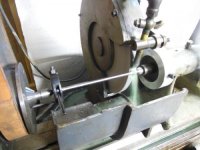With the Gritter's method, the non piloted end of the range rod is held by a chuck in the tail stock. The bushing rides at the throat or somewhere around the start of the chamber depending upon where you want to check the barrel. The indicator point presses against the range rod right in front of the barrel. The range rod doesn't turn with the spindle of the lathe. I don't see that it makes too much difference how straight the rod is as all you are doing is checking the runout of the bushing by running the point against the range rod away from the bushing and minimizing deflection of the range rod as you indicate in the bushing. If you use the Tru bore range rods with two bushings inside the bore, the range rods would have to be straight and concentric to the center line of the bushings as you measure runout up and down the range rods. Just my take on it and worth about as much as the space it takes up. I don't know whether you've had any response, but may be why there haven't been any replies. I saw a post once about hanging a weight off the end of the range rod. If you do it the way the Gritter's video shows, there isn't any need for a weight to be hung off the range rod. FWIW, I don't use either the Gritter's method or the Tru Bore method. I do have the Gritter's rods and use them to check bushing sizes down the bore of the barrels. I also have the Tru Bore rods, but haven't used them. I ordered them with the Tru Bore chuck when I bought it for truing actions.



